How to Successfully Manage Garden Insect Pests
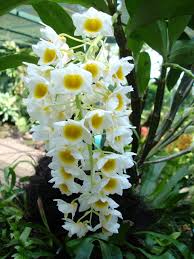
For plant life to survive the right requirements must be met. This is known as “Proper Cultural Practices” meaning that plants must be placed in the right location whether full, partial, or filtered sun, also the proper soil medium is needed, the right amount of water, along with the correct type and amount of fertilizer and correct pruning methods.
When plant requirements are met, there is less chance that they will be attacked by insects because insects attack plants that are stressed.
When selecting plants from your nursery, it is always important to note the condition of the plants you want to purchase. Are they sturdy-looking? Is there any sign of bug infestation, discoloration of the leaves, or drooping leaves when already watered?
Choosing healthy plants from inception is vital if you desire to have a garden that thrives with speechless beauty. So ask questions before purchasing. How big does it grow? What type of soil is best? Is it a shade, sun, or partial sun lover? How much water does it require in a week? These answers are your keys to “Proper Cultural Practices”.
MealyBug Control
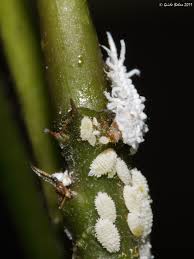
Besides proper plant care, you may have a few unwanted visitors from time to time. If this happens to you stay cool and counterattack. Insecticidal soaps can be used to control mealybugs, just read the instructions or label carefully, and apply as directed.
There are many other products that can be used but make sure these products are safe around children and pets like insecticidal soaps.
Another safe method that can be used to control mealybugs is Ivory dish liquid, rubbing alcohol, and water. In a 32 oz spray bottle, mix about half a teaspoon of dish liquid with a cover of rubbing alcohol along with filling the spray bottle with water, shake well then apply. Get full coverage of both the top and the undersides of the leaves.
Make sure you have adjusted the spray nozzle so that the solution comes out fine and misty for proper coverage, leave the solution on for about 2-3 hours then rinse thoroughly with fresh water. Monitor plant and repeat at seven-day intervals if necessary. However do not use dish liquid and water mixture on hairy plants, as this mixture can damage these types of plants.
Aphid Control

Aphids can also present a big problem in our gardens and landscape. Aphids like mealy bugs need the right condition in order to survive, as noted earlier aphids are green pear-shaped insects that feed on the tender or new growth of plants and if left unchecked can cause major damage to plant’s life.
For more details, you can check out the section on garden pests and PEST CONTROL.
The good news, however, is beside using chemicals such as talstar, upstar, insecticidal soap, and other brands on the market, you can use a simple mixture of dish liquid and water. You can find how to apply this mixture in the section on how to control mealy bugs.
A strong spray of water from your garden hose can do the trick of knocking aphids off your garden plants and killing them.
If you have a hand pruner you can also remove the infected parts instead of using chemicals. This method is called mechanical control.
Whitefly control
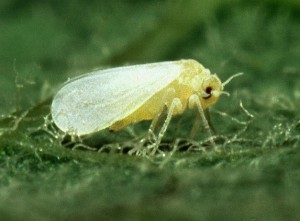
Whiteflies are small white insects that live on the underside of the plant leaves, a good way to test see if you have whiteflies is to gently tap the branches of the plant. If there are whiteflies present, you will see tiny white insects flying up from your plants, and then as quickly as they fly from the plant they will reattach themselves back to the plant again.
The eggs of whiteflies are yellow or greyish and are shaped like a cone. They are so tiny they are about the size of a pinpoint. The number of whiteflies can increase very quickly when the weather is warm. They lay their eggs on the underside of the plant leaves.
The four stages of whiteflies from young to adult are as follows.
*The first stage is the Nymphal Stage. At this stage, they begin to move about on the plant.
*In the second stage they are oval and flattened.
*In the third stage the legs and antennae are reduced.
*In the fourth stage, the mature adult with its already developed wings emerges.
Whiteflies belong to the family of insects that suck the juice from plants causing great damage to plant life.
You can read about this in the section on garden pests and pest control. Females lay between 200-400 eggs per time. The eggs hatch in about a week and the Nymphs emerge.
In some cases, whiteflies can be controlled mechanically by removing the infected part depending on the degree of the infestation, or they can be controlled chemically. There are many brands on the market that should only be used by a professional applicator.
Some of these include:
Insecticidal soaps, horticultural oils, botanical insecticides, and takedown.
Thrips control

Thrips are another insect that you don’t want to see invading your gardens and landscapes, like the insects we discussed above, this sucking insect can cause major damage to plant life. Thrips are also known to stunt growth in plants.
Over the years I have dealt with them and have seen their destruction. I have seen plants that were lush and healthy suddenly lose most of their leaves and in some cases all of their leaves.
The infected leaves turn yellow and then brown, falling to the ground and leaving the tree or plant looking bare and naked. Thrips hatch from eggs and develop through two larval stages.
The PRE-PUPA and the PUPA stage and later the adult stage. Thrips can reach from egg to adult in about two weeks as long as the weather is warm.
To effectively control Thrips, I have used product brands such as Orthene, Bayer Advanced 3 in 1, Multi-Insect Killer, Talstar, and Upstar. There are many other brands available that can be used to effectively control thrips.
Spider mite control
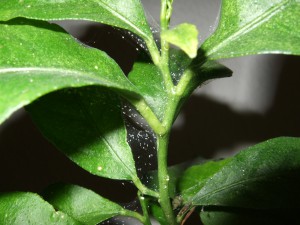
Spider mites are also a nuisance to plant life because they do what all of those insects that we have already discussed does and that is suck the juice from the plant causing damage. My experience with this insect is that in heavy infestation the leaves of plants are covered in spider’s web and can take on a greyish dusty appearance.
Spider mite’s life cycle develops in two nymphal stages egg, larva, and then adult. Also, spider mites are not true insects but are classed as a type of “Arachnid” relative to spiders, ticks, and the scorpion family. Spider mites live on the underside of plant leaves. The adult female can lay up to several hundred eggs during her life.
What I have discovered in dealing with these insects is that by using dish liquid and water you can eradicate this pest completely. (See proper mixture for this solution on mealybug control). I have also used insecticidal soaps and many of the brands that are mentioned in this article and have experienced success.
Birch leaf miner control
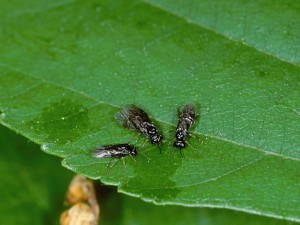
As we have noted in the article on GARDEN PESTS we have established some facts about the Birch leaf miner, now we will be looking at ways to control these insects. Their eggs can be found on the underside of clustered plant leaves.
They hatch and begin to eat away at the leaves for about 1-3 weeks, then they pupate for 2-4 weeks inside the plant’s leaves or drop to the ground surface below burrowing into the soil and when they emerge they are adults.
The leaves on plants that are affected by these insects turn light green with grey spots. The areas of the leaf turn this color because this is where the female lays her eggs. When the eggs hatch the larva begins to feed on the leaves damaging the host plant.
The leaves may also have brown blotches. Control methods include using Borer-miner killer spray, drenching the soil with a liquid insecticide, or applying Bayer advanced tree & shrub insect control.
1. Pick infested leaves from your plants.
2. Remove any clusters of eggs that are visible.
3. Release beneficial insects into your garden area.
4. Insecticidal soap spray
5. Neem oils
6. Horticultural Oils
These are just some of the control methods that you can use to combat these insects.
Gypsum moth control
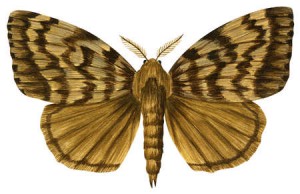
Gypsum moth as we have seen in the article on garden pests is very beautiful moths, but don’t let your eyes deceive you. This month is known to cause destruction to plants and if not brought under control the damage can become extensive.
We have studied their life cycle in the previous article on GARDEN PESTS, now let’s see how we can control these insects.
- Botanical insecticides.
- Gypsum moth foggers.
- Gypsum moth sprays
- Neem oil.
- Biological control involves beneficial insects.
- Placing sticky bands on the tree.
WORD OF CAUTION!
Whenever treating plants with chemicals, make sure that the plant is well watered the day before because using chemicals on a plant that is already stressed and insect-infested can further cause a plant to experience setbacks.
When using chemicals remember the label is LAW so follow the label instructions.
For more Great Advice on How to Compost you can check out My Friend Stephen’s Post below.
What is the best way to Make Compost?
Gardening -Guru
My Friend Stephen.
Stephen is a friend of mine who lives in Vietnam
He, like me, is crazy about gardening and I strongly recommend you check out his website. Here is something he has written about common garden pests in the USA . And he has a lot of other blogs as well. Take the time and look at his website today. I promise you it is worth the time and effort.
For great tips on what is the best way to Make Compost please check it out here. “Common garden pests in the USA“
Be patient you’re almost there!
The benefits of creating a compost pile
Leafhopper control

Leafhoppers are a group of insects that are among the largest groups of insects worldwide. These insects are destructive to crops and can create millions of dollars in damage. Leafhoppers do their damage by piercing the plant tissues and sucking the plant’s sap.
The most common colors of leafhoppers are green and brown though they can be found in many different colors. Females lay their eggs in the plant stem. The eggs hatch in the spring and then the nymphs or babies feed on the underside of the leaves.
Leaves of infected plants develop yellow specks or spots. The leaves may also turn a pale yellow and the growth of the plant may be stunted. Leafhoppers can be controlled effectively by applying Pyrethrins. Yellow sticky traps can also be used to bring these insects under control.
Colorado potato beetle control
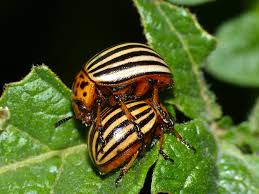
Colorado potato beetle causes damage to eggplants, potatoes, and tomatoes. Eggs are laid on the underside of the leaves. The females can lay up 400 or more eggs in a 4-6 weeks period. The eggs hatch in about 4-9 days and the larva begins to feed on the potato leaves.
The mature larva burrows into the ground to pupate in 5-1o days. After this time period, the beetles emerge as adults. Control measures include Bacillus Thuringiensis Var Tenebrionis. This is very effective against young beetles but not as effective against them at the adult stage so timing is important.

Azadirachtin can manage these beetles to a certain extent by releasing beneficial insects such as ladybugs and lacewings that will feed on the eggs at the crawling stage of these insects.
Scales
Scales can do much damage to plant life by sucking the sap from plants causing the leaves to turn yellow and then brown. There are many species of scales worldwide. The excrement of these insects is known as honeydew. Sooty mold forms on the plant because of this honeydew. Females lay their eggs under the protection of their shells and these eggs hatch in about one to three weeks.
Sooty mold is black and covers the surface of plant leaves causing it to look very unhealthy. This mold can also interfere with the plant’s photosynthesis process (how the plants make their food). Scales can be controlled by using insecticidal soap sprays, horticultural oil, etc… or by releasing beneficial insects into your garden areas such as ladybugs.
Crucifer flea beetle control
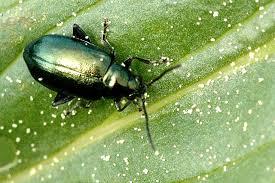
These beetles can cause severe damage to crops. Adult beetles burrow in soil and leaf litter during cold weather. In the spring they become active and mating takes place. The female beetles lay their eggs in the soil next to the host plant. The eggs hatch in about five days.
The larva then begins to feed on the roots in the soil. The larva undergoes 3 stages while burrowed in the soil. Mature beetles emerge from the soil and continue to feed causing damage. These beetles can be controlled by making sure that your garden area is free of leaf debris.
Using a botanical insecticide is effective in controlling these insects. Also, oils such as Pyrethrin, Rotenone, Neem oil, etc… helps to bring these beetles under control.
Gnats
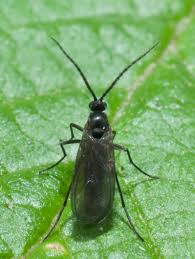
Gnats are small and grey or black. These insects travel in groups and can really become a pest especially when they flying up your nose. Gants love moist conditions with organic- matter because this is where the maggots live until they reach maturity.
One way to control is by decreasing the amount of water when watering plants until gnats are brought under control. Another method of control is to use a stick yellow trap.
The final word on pests control methods
While keeping your garden and landscape completely free of pests is impossible, what is possible though is that we can keep these pests at an acceptable level where they can not do excessive damage to our landscapes or gardens. Remember to keep plants as healthy as possible by providing the proper soil, planting in the right location,
the right amount of water, and the right amount of fertilizer. These methods can go a long way in your plant’s survival remember when applying chemicals read and follow directions because the label is the LAW. So by keeping these tips in mind, we can have healthy plants while winning the war on bugs.
About the author
Norman loves being in the garden, both at home and for his job....
he is 'Natures Little helper' being outdoors, growing his vegetables and flowers from an early age.
Now having spent over 22 years in the profession he want to give some of his knowledge to others...
his vast array of hints and tips you will find scattered over this site will help you no end growing plants in your garden.


When I was younger my mom had a garden filled with fruits and veggies, and I always thought it was healthier to do it that way.
I want to grow a garden as well and this information will help me keep it healthy, even if there are just flowers in it.
Thank you!
Hello Karissa thanks for the follow i am glad that i could help, and i wish you success with your flower garden. Have a good day.